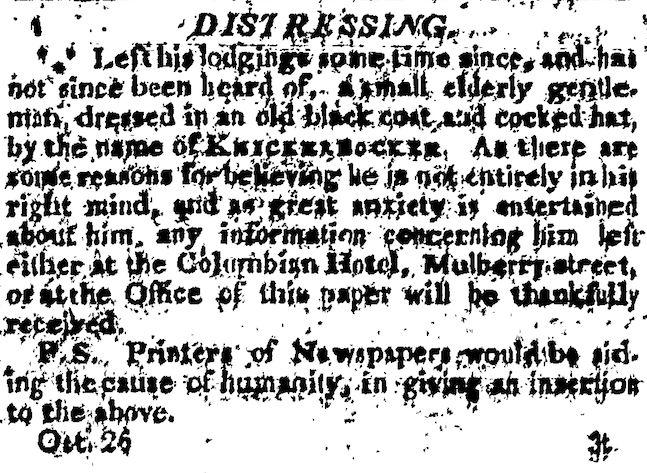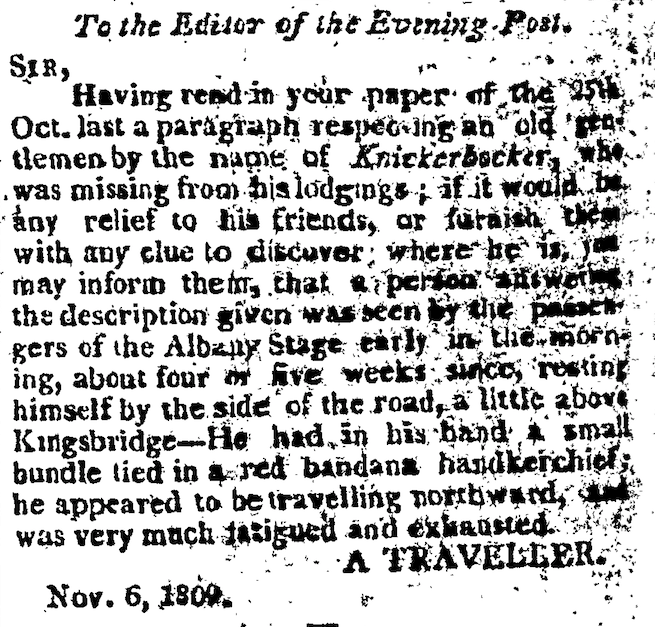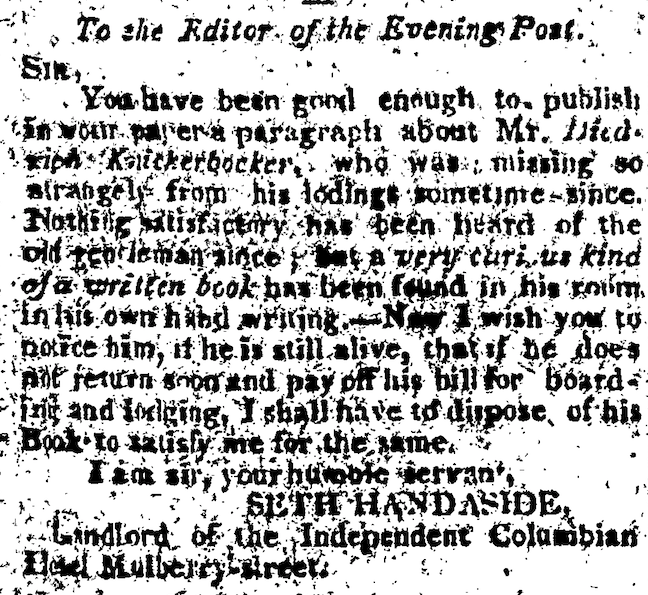Home › Forums › The Industrial Era › Knickerbocker Advertisements
- This topic has 2 replies, 3 voices, and was last updated 4 years ago by
yhistlvr.
-
AuthorPosts
-
-
April 22, 2020 at 11:09 pm #1363
In 1809 a series of advertisements started to appear in the New York Evening Post. Here is the first from October 26th (transcribed on the side):

Distressing
Left his lodgings sometime since, and has not since been heard of, a small elderly gentleman dressed in an old black coat and cocked hat, by the name of KNICKERBOCKER. As there are some reasons for believing he is not entirely in his right mind, and as great anxiety is entertained about him, any information concerning him left either at the Columbian Hotel, Mulberry street, or at the Office of this paper will be thankfully received.
P.S. Printers of Newspapers would be aiding the cause of humanity in giving an insertion to the above.
Then, a couple of weeks later, on November 6th, the following was printed (transcribed below):
 To the Editor of the Evening Post.
To the Editor of the Evening Post.SIR,
Having read in your paper of the 25th Oct. last a paragraph respecting an old gentlemen by the name of Knickerbocker, who was missing from his lodgings; if it would be any relief to his friends, or furnish them with any clue to discover where he is, you may inform them, that a person answering the description given was seen by the passengers of the Albany Stage early in the morning, about four or five weeks since, resting himself by the side of the road, a little above Kingsbridge–He had in his hand a small bundle tied in a red bandana handkerchief; he appeared to be travelling northward, and was very fatigued and exhausted. – A TRAVELLER.
New Yorkers began to take notice. 10 days later, the following appeared in the Evening Post:
 SIR,
SIR,You have been good enough to publish in your paper a paragraph about Mr. Diedrich Knickerbocker, who was missing so strangely from his lodgings sometime since. Nothing satisfactory has been heard of the old gentleman since; but a very curious kind of a written book has been found in his room in his own hand writing. –Now I wish you to notice him, if he is still alive; that if he does not return soon and pay off his bill for boarding and lodging, I shall have to dispose of his book to satisfy me for the same.
I am sir, your humble servant,
Seth Handaside, Landlord of the Independent Columbian Hotel Mulberry Street.
Not long after, on December 7th, the following was published:
 This day is published by Inskeep & Bradford, No. 18 Broadway,
This day is published by Inskeep & Bradford, No. 18 Broadway,A HISTORY OF NEW-YORK,
In 3 vols duodecimo, price 3 dollars, containing and account of its discovery and settlement, with its internal policy, manners, customs, wars, etc, etc, while under the Dutch government; furnishing mans curious and interesting particulars never before published, and which are gathered from various manuscripts and authenticated measures, the whole being interspersed with philosophical speculations and moral precepts.
This work was found in the chamber of Mr. DEIDRICH KNICKERBOCKER, the old gentleman whose sudden and mysterious disappearance, has been noticed–It is published in order to discharge certain debts he has left behind.
New York began buzzing about the book and a couple of weeks later, the following was printed in the paper:
 HISTORY OF NEW-YORK
HISTORY OF NEW-YORKNo work has ever appeared in this country which has excited so much curiosity as the History of New-York, written by the celebrated Diedrich Knickerbocker, an old gentleman who lately strayed from his lodgings, and has never since been heard of. A gentleman of great taste and genius, in a letter to his friend speaks of the work thus: “If it be true as Sterne says, “that a man draws a nail out of his coffin every time he laughs, after reading_____’s book, your coffin will certainly fall to pieces.
The applications for this extraordinary history have been numerous at the different bookstores.
[communicated]
Whereas sundry reports injurious to the character of Diedrich Knickerbocker, are at present in circulation, setting forth that said Knickerbocker is not the author of the “History of New York,” about to be published in his name, and even attacking the very existence of Knickerbocker himself; and considering him as an ideal person. The undersigned, the most tried and faithful of Diedrich’s friends, takes this method of informing the public that said reports are malicious and without foundation, orginiating, he verily believes, in envy, excited by the unheard of reputation that Knickerbocker will reap from the publication of his authentic and interesting history–From his intimacy with Diedrich, the undersigned has had frequent opportunities of seeing the original [manuscripts] in the hands of Knickerbocker himself, a short time previous to that gentleman’s mysterious and melancholy disappearance – LUDWICK VON BYNKERFELDT
Only later would Washington Irving admit that he was in fact the true author of “History of New-York” and that Diedrich Knickerbocker was a figment of his imagination–and that all of the above newspaper clippings were penned by Irving himself. New Yorkers were completely amazed and captivated by this marketing campaign and the book sold very well. It is something of a mythological retelling of New York’s history and includes some items of local interest–such as the origins of the name “Spuyten Duyvil.” According to “Knickerbocker,” the Dutch trumpeter Anthony van Corlear swam across the creek “in spite of the devil” to warn locals of an English attack. Many stories like this were absorbed by the collective memory of New Yorkers and repeated as fact over the years.

Painting By Charles Loring Elliott – Walters Art Museum: Home page Info about artwork, Public Domain, https://commons.wikimedia.org/w/index.php?curid=18804936
-
April 22, 2020 at 11:54 pm #1365
I have to be honest…..I was this coming right from the first article of the name Knickerbocker…But, I did enjoy how the marketing strategy was unfolding…wondering what the current reader thought about when reading the notices.
-
April 23, 2020 at 1:37 am #1366
The New York Genealogical and Biographical Record
Devoted To The Interests Of American Genealogy And Biography
Issued Quarterly
Published By The New York Genealogical And Biographical Society,
226 West 58th Street, New York.
THE KNICKERBOCKER FAMILY
By William B. Van Alstyne, M.D.
Chapter 1
(Published January 1908)
NYG&BR, January 1908 Page 33
The Knickerbocker family of New York, rendered famous by the genius of Washington Irving, has never to our
knowledge been printed in genealogical form. This we now endeavor to do for the first four or five generations.
Pains have been taken to secure accuracy and authorities are given for most statements. Traditions are current in
the family concerning its origin and history in Holland, but these the writer, not finding leisure to verify them, has
omitted. He has encountered many early spellings of the name of the family, such as Knikkerbakker,
Knikkelbakker, and Knikkenbakker, but has adhered to the present spellings, Knickerbacker and Knickerbocker.
Authorities differ as to the origin of the name Knickerbocker. William Arthur (Derivation of Family Names, p.177)
derives it from knacker, a cracker, and backer, a baker; while Edward M. Smith (History of Rhinebeck, N.Y., p. 174)
derives it from knikker, a marble, and bakker, a baker. Consensus of opinion favors the latter explanation.
Harmen Jansen Knickerbocker, the ancestor of the family, came to this country from Holland prior to 1683 and
settled at Albany, N.Y. Occasionally he added the termination Van Wie to his name indicating that he came from
Wie, the present Wyhe, a few miles south of Zwolle, in the Province of Overyssel, Holland.
In 1683, Harman Jansz Knickelbacker and Lysbet Harmensz were members of the Dutch Reformed Church at
Albany (Year Book, 1904, of the Holland Society of New York, p. 5).
On 6 May, 1684, Harmen Jansen Knickerbocker deeded land in Albany to Mews Hogeboom (Book 531, Public
Records of Albany Co). On 2 June, 1688, Peter Schuyler received a grant of land in Dutchess County near Red Hook
-
-
AuthorPosts
- You must be logged in to reply to this topic.